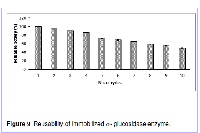Induction, immobilization, modification and natural inhibitors of α-glucosidase from Penicillum chrysogenum
Keywords:
P. chrysogenum, α-glucosidase, Induction, Modification, Immobilization, InhibitionAbstract
α-glucosidase (EC: 3.2.1.20) was isolated from Penicillum chrysogenum. The enzyme was enhanced by plant growth regulators such as gibberellic acid (GA3), benzylaminopurine (BAP) and kinetin. Dansyl chloride inhibited the enzyme at 1, 2, 3, 4 and 5 mM with T0.5 67, 52.2, 34.4 and 23.3 min, respectively. The substrate offered partial protection for the enzyme against dansyl chloride inhibition. The enzyme was activated by Ca2+ and Mg2+. However, Pb2+, Cd2+, Zn2+, Ni2+ and Hg2+ inhibited α-glucosidase activity. The enzyme was immobilized on Ca alginate and the optimal concentration for 3% w/v. The optimal concentration of CaCl2 was recorded at 3 mM. The optimal CaCl2 concentration and the optimum time for immobilization was 3mM and 4hr. The enzyme was inhibited by aqueous extracts of Datura stramonium, Trigonella foenum-graecum, Hyoscymus muticus and Cynodon dactylon. The IC50 values for the four extracts were 59.1, 73.6, 68.5 and 77.1 µg ml-1, respectively.
References
Brena, Beatriz M., and Francisco Batista-Viera. "Immobilization of enzymes." Immobilization of enzymes and cells. Humana Press, 2006. 15-30. [2] Bai, Yong-Xiao, et al. "Covalent immobilization of triacylglycerol lipase onto functionalized novel mesoporous silica supports." Journal of Biotechnology 125.4 (2006): 574-582. [3] Tanino, K. K., Kalcsits, L., Silim, S., Kendall, E., and Gray, G. R. Temperature-driven plasticity in growth cessation and dormancy development in deciduous woody plants: a working hypothesis suggesting how molecular and cellular function is affected by temperature during dormancy induction. Plant Molecular Biology, (2010), 1-2: 49-65. [4] Eaton, A. D., Clesceri,L. S., Greenberg, A. E., Standard Methods for the Examination of Water and Waste water, 20th Ed., American Public Health. Association. Washington, USA. 1998. [5] Vanderzant, C., Splittstoesser D. F. Compendium of methods for the microbiological examination of food, 3rd ed. A. Pub Hea. Asso, Washington, D.C.; 1992. [6] Bihzad, M.A. and H.M. El-Shora. Phosphoenolpyruvate carboxylase from Rumex dentatus, a C3-plant. Journal of Plant Physiology (1996), 149: 669-676. [7] El-Shora, H. M., Ahmed M. El-Shobaky, and Maissa M. El-Atrozy. "Activity of purified bacterial myrosinase and its essential residues." International Journal of Current Microbiology Applied Science 5 (2016): 567-578. [8] El-Shora, H. M. "Effect of growth regulators and group-modifiers on NADH-glutamate synthase of marrow cotyledons." Journal of Biological Science 1.7 (2001): 597-602. [9] Kaur, S, Gupta A. K. and Kaur N (2000). Effect of GA3 , kinetin and indole acetic acid on carbohydrate metabolism in chickpea seedlings germinating under water stress; Plant Growth Regulators. 30: 61–70. [10] El-Shora, H. M. and Metwally, M. Effect of phytohormones and group selective reagents on acid phosphatase from Cladosporium cladosporioides. Asian Journal of Biotechnology (2009), 1: 1-11. [11] Abdel-Ghaffar, F., Marzouk, M., Ashour, M. B., and Mosaad, M. N. Effects of Eimeria labbeana and E. stiedai infection on the activity of some enzymes in the serum and liver of their hosts. Parasitology Research, (1990), 5: 440-443. [12] Ananiev, E.V., Barsky V.E., Ilyin Y.V., and Churikov N.A. Localization of nucleoli in Drosophila melanogaster polytene chromosomes. Chromosoma. (2003),81: 619-628. [13] El-Shora, H.M., Youssef M.M. and Salwa A.K. Induction and immobilization of asparaginase from Aspergillus niger. Biochemical Letter., (2005) 1: 35-46. [14] El-Shora, H.M., Khalaf, S.A. and Zaki, M.O. Active residues and immobilization of cyanide hydratase from Cladosporium oxysporum. International Journal of Science Research. (2015) 7: 455-465. [15] El-Shora, H.M., and Metwally, M.A. Production, purification and characterization of proteases from whey by some fungi. Annals of Microbiology, (2008), 58: 495-502. [16] Kaiser, E. T., Lawrence, D. S. and Rokita, S. E. The chemical modification of enzymatic specificity. Annals Review Biochemistry. (1985), 54: 565-595. [17] El-Shora, H. M. and Abo-Kassem, E. M. Regulation and characterization of phytase activity in Latuca sativa cotyledons. Bull Faculty of Science Assiut University. (2000), 29: 389-403. [18] El-Shora, H. M., El-Shobaky, A. M., and Ghoneim, J. E . Activity of glucose isomerase from Bacillus thuringiensis under Different Treatments. Inter of Journal of Current Microbiology Applied Science, (2016) 2: 579-589. [19] Srivastava, P. K., and Kayastha, A. M . Significance of sulfhydryl groups in the activity of urease from pigeonpea (Cajanus cajan L.) seeds. Plant Science, (2000) 1: 149-158. [20] Kwon, Y. I., Apostolidis, E. and Shetty, K . Evaluation of paper Capsicum annuum, for management of natural product, Mini-Reviews in Medical Chemistry. (2007), 6: 349-356.



